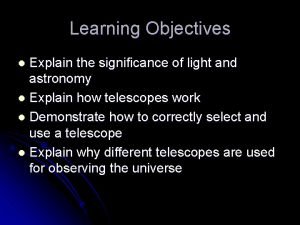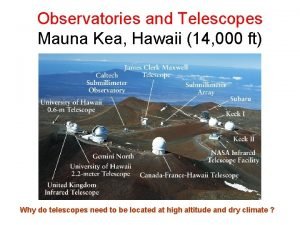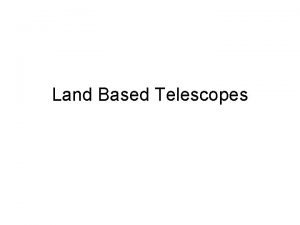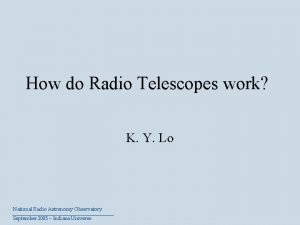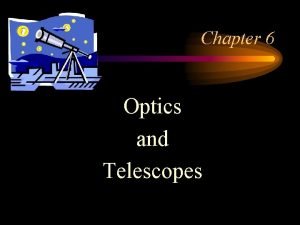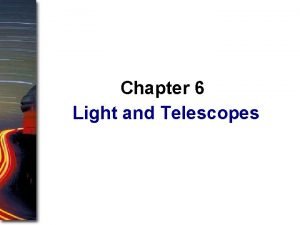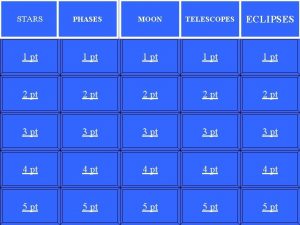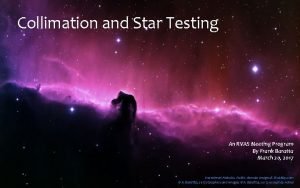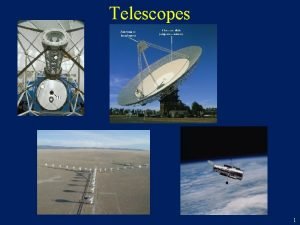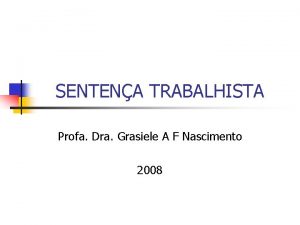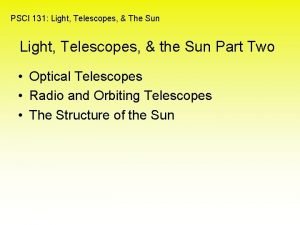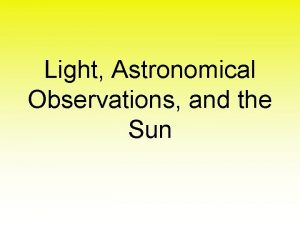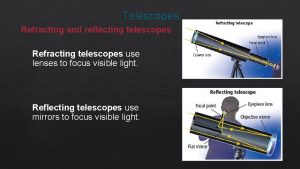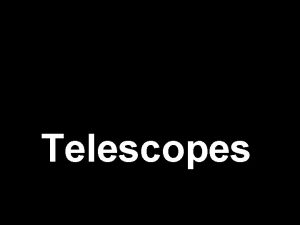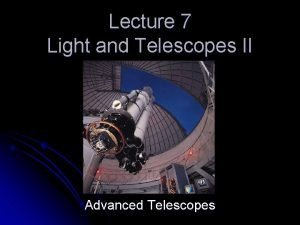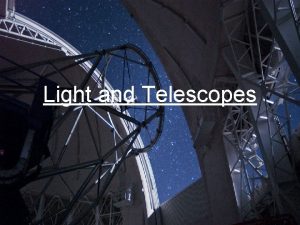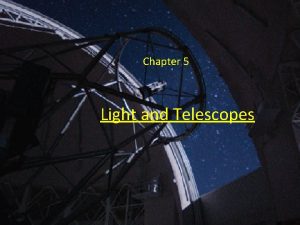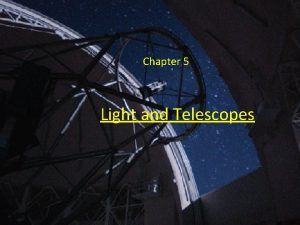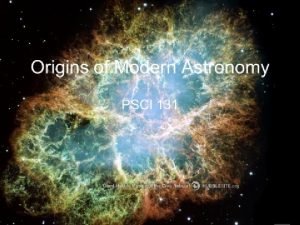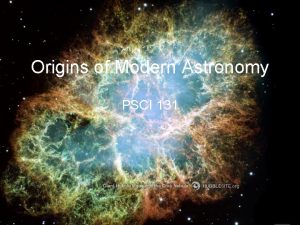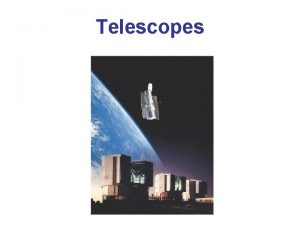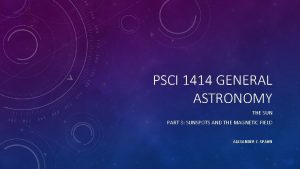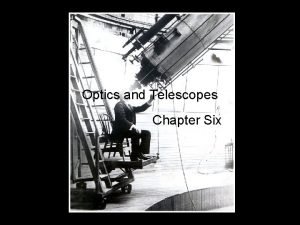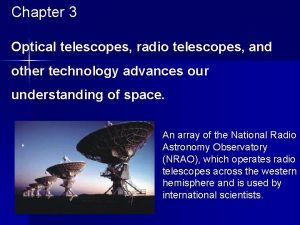Light Telescopes and the Sun PSCI 131 Light





















- Slides: 21

Light, Telescopes, and the Sun

PSCI 131: Light, Telescopes, & The Sun Light, Telescopes, & the Sun • Light: Messenger From Space • Spectroscopy • The Doppler Effect

PSCI 131: Light, Telescopes, & The Sun Electromagnetic (EM) Spectrum • Energy waves (radiation) emitted by matter

PSCI 131: Light, Telescopes, & The Sun Nature of Light • Wave properties – Wavelength: Distance from one wave crest to the next – Frequency: The number of waves that pass a point during 1 second – Can’t see most light because it occurs at wavelengths that are too long or too short for our eyes • Visible light or white light is the light that humans can see

PSCI 131: Light, Telescopes, & The Sun Nature of Light • Particle properties – Light particles (photons) can exert pressure on matter (radiation pressure) – Photons have specific amount of energy, related to wavelength • Short wavelengths – more energetic photons – Gamma rays are the most energetic, while radio waves are least – X-rays – plow through matter before they are absorbed » Readily pass through soft tissue but are absorbed by bones which are denser.

PSCI 131: Light, Telescopes, & The Sun EM Radiation from Celestial Objects • Emitted radiation can be collected and used to study the object – Telescopes: optical, radio, space-based – Spectroscopy

PSCI 131: Light, Telescopes, & The Sun What Can We Learn from Light?

PSCI 131: Light, Telescopes, & The Sun What can we learn from light? • Most astronomical observations can only use light radiation – Most objects too far away to visit • Spectroscopy: study of light and the way it interacts with matter – Spectra can give key information about the object the light came from • Spectroscope: an instrument that contains a prism that spreads out the wavelengths of light so that they can be accurately measured.

PSCI 131: Light, Telescopes, & The Sun Continuous Spectrum • Uninterrupted band of light emitted by an incandescent solid, liquid, or gas under pressure – Continuous band of wavelengths that looks like the rainbow • Shows surface temperature of object • Shows total energy emitted by object

PSCI 131: Light, Telescopes, & The Sun Continuous Spectrum Shows Surface Temp exaggerated COOLER HOTTER

PSCI 131: Light, Telescopes, & The Sun Continuous Spectrum Shows Total Energy • Proportional to fourth power of object’s surface temperature (Stefan-Boltzman law) – Example: if Star B is five times as hot as Star A… – …Star B emits 54, or 5 x 5 x 5 = 625 times more energy that Star A

PSCI 131: Light, Telescopes, & The Sun Emission Line Spectrum • Bright lines produced by an incandescent gas under low pressure • Shows what elements are present in object – Each element emits a unique wavelength pattern when heated

Absorption Line Spectrum

PSCI 131: Light, Telescopes, & The Sun Absorption Line Spectrum • Dark lines produced when white light is passed through a comparatively cool, low-pressure gas • Shows what elements are present in object – Each element absorbs a unique pattern of visible light wavelengths

Which elements are in this mystery star?

PSCI 131: Light, Telescopes, & The Sun Light tells us about • Composition – Elements emit and absorb a unique set of wavelengths • Temperature – All objects radiate a continuous thermal spectrum – Hotter objects emit more light per unit area and emit more of their light at shorter wavelengths (higher energy) • Motion of distant objects (Doppler effect)

PSCI 131: Light, Telescopes, & The Sun The Doppler Effect • Apparent shift in wavelength relative to a stationary observer

PSCI 131: Light, Telescopes, & The Sun Red and Blue Shift • Light waves undergo Doppler Effect

PSCI 131: Light, Telescopes, & The Sun Red/Blue Shifts Change Absorption Spectra • Star moving away from Earth = RED shift • Star approaching Earth = BLUE shift • Large shifts either way indicate high velocities

Types of Doppler shifts • Caused by local motions – How fast one star orbits another (2 -star system) – How fast a pulsating star expands or contracts • Caused by expansion of universe – How far away distant objects are

Our Farthest Travels In Space • Voyager 1 and 2
 Psci audit
Psci audit Pharmaceutical supply chain initiative psci
Pharmaceutical supply chain initiative psci Pharmaceutical supply chain initiative psci
Pharmaceutical supply chain initiative psci Refracting telescopes exhibit great focus and color
Refracting telescopes exhibit great focus and color A building that contains one or more telescopes
A building that contains one or more telescopes Chromatic aberration affects reflector telescopes.
Chromatic aberration affects reflector telescopes. Land based telescopes
Land based telescopes Computer controlled telescopes
Computer controlled telescopes How do radio telescopes work
How do radio telescopes work Modern telescopes make it possible for astronomers
Modern telescopes make it possible for astronomers All modern large optical telescopes are refractors.
All modern large optical telescopes are refractors. The design of modern x-ray telescopes depends on
The design of modern x-ray telescopes depends on New moon telescopes
New moon telescopes Star testing telescopes
Star testing telescopes Timeline of telescope
Timeline of telescope Structure of radio telescope
Structure of radio telescope Light light light chapter 23
Light light light chapter 23 Light light light chapter 22
Light light light chapter 22 Light light light chapter 22
Light light light chapter 22 Solar energy is radiant light and heat
Solar energy is radiant light and heat Phy 131 past papers
Phy 131 past papers Art. 131 cpc
Art. 131 cpc



